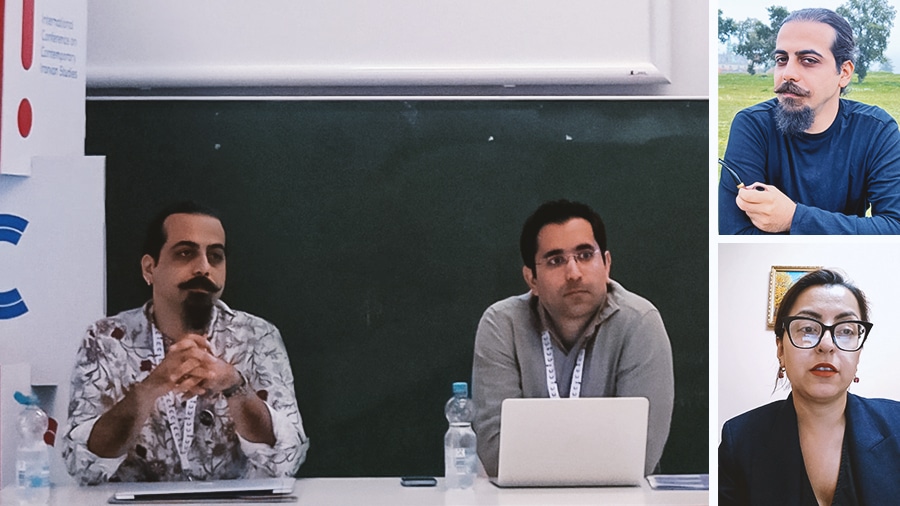Arpine Arushanyan
Taboos and Their Transformation Among the Yāresān
Masih Karimi
Yāresānism and the Role of Women in Ritual Music of Yāresān
Moderator: Iqan Shahidi
Abstracts
Arpine Arushanyan
Taboos and Their Transformation Among the Yāresān
The Yāresān (Community of Friends), known also as Ahl-e Haqq (People of Truth), or Kākai (Member of the Brotherhood), are a religious minority or an esoteric Shi‘a community (sometimes considered to be a separate religion, due to the worship of ʿAlī ibn Abī Ṭālib), that appears to have emerged among the Guran of southern Kurdistan in the 15-16th century C.E. Nowadays they live in various parts of Iran (especially in the Kermanshah region) and Iraq (near Erbil, Mosul, Kirkuk, Khaneqin and Halabja), as well as with some small groups among the Kurdish diaspora in Europe.
Having survived for centuries at the crossroads of various religions, their beliefs are a mixture of Islamic and non-Islamic elements. Considered to be heretics, non-Muslims and “devil worshipers” by the Islamic clergy at different times, they had to keep their religious affiliation as secret as possible, trying not to assimilate with the peoples of the region and to preserve their faith.
Today, as a result of long wars in the Middle East and migration, the Yāresān who have settled outside the region, particularly in Europe, are facing new challenges in order to preserve their identity and religion. Such conditions, of course, force the community to put various restrictions and limitations, and separate themselves from the cultural and religious environment they live in.
These taboos, however, over time, are losing relevance and no longer serve their purpose, change their forms and give way to new methods of preserving identity. Taboos among the Yāresān mainly refer to shaving the moustache, women’s participation in ritual ceremonies, intermarriage (both between the two castes, Sayyeds and Murids and outside the community, between the Yāresān and the Twelver Shi‘a). The main taboo, however, concerns the religious secret of the Yāresān, known as serr-e magu, “a secret that cannot be told.”
For centuries, the Yāresān did not allow foreigners to participate in any ritual of the community, whether religious or secular, they did not sing religious hymns or kalams in their presence, speak about religious beliefs, leading many believers to practice taqiye (dissimulation). The situation, however, began to change in the 20th century, when the Yāresān came to the attention of researchers, whose works included details impossible to write down without familiarity with the community’s life.
Later in the mid-20th century books and sacred texts, previously transmitted orally only by Sayyeds and inaccessible for illiterate Yāresān, were published even by representatives of the community, blurring the boundaries between the Yāresān and the world.
Today, it is not realistic to talk about taboos on religious texts and songs, when they are open access, in the form of articles and videos on various Internet platforms. On the contrary, they not only no longer threaten the preservation of identity, but are also a bridge between the Yāresān communities living in different countries of the world.
Masih Karimi
Yāresānism and the Role of Women in Ritual Music of Yāresān
The main objective of this article is to discuss the religious and social role of women in the religious and ethnic minority of Yāresān, and especially in its musical field. Since Yāresān music and the repertoire of the Tanbur’s role are intertwined with Yāresān culture and religion and are inseparable, it is necessary to properly introduce the Yāresān ethnic minority, its religion and social circumstances.
Considering that for this purpose, a relative understanding of the Yāresān religion and its history is necessary, we begin with the introduction of the Yāresān religion as one of the religious and social minorities. From there we move on to introducing the Yāresān ritual along with its musical repertoire. Finally, we discuss the position of women in this landscape.
This exploration includes various aspects such as geography, language, etymology, beliefs, and history. The various views that orientalists and researchers have about the Yāresān religion are pointed out. The Tanbur repertoire and the Yāresānism musical aspect is one of the basic elements of this ritual and makes Yāresān one of the most unique religions in history, which is inseparable from its musical dimension.
In the Yāresān religion, music and art have become a means for religious rituals, and for this reason, it is considered sacred and bears high sensitivity. However, in recent years, many taboos have been broken, making this ritual more known and out of its closed and secret state. These taboos were broken both in the field of music, which is considered religious in a way, and in the social field.
In this article, an attempt is made to discuss the influence of Islam on the Yāresān religion, which is said to be a survivor of Mehr and Mithraism. Also, we briefly discuss some of the common mistakes made among the general public about Yāresān people and their beliefs.
Finally, in this research, an attempt is made to dive into the historical, artistic, and social aspects of the subject without bias, with a critical view, and a feminist approach.


